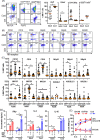Cord blood-derived iNK T cells as a platform for allogeneic CAR T cell therapy
- PMID: 40519924
- PMCID: PMC12162299
- DOI: 10.3389/fimmu.2025.1621260
Cord blood-derived iNK T cells as a platform for allogeneic CAR T cell therapy
Abstract
CD1d-restricted invariant Natural Killer (iNK) T cells are a suitable candidate for allogeneic Chimeric Antigen Receptor (CAR) T cell therapy as they do not cause graft-versus-host disease (GvHD) due to the monomorphic nature of CD1d proteins. However, the phenotypic and functional heterogeneity of iNK T cells from adult donors (AD) may lead to the inconstant CAR-iNK T cell products. Cord blood-derived (CB) iNK T cells, in contrast, exhibit inter-donor homogeneity in phenotype including uniform CD4 expression and are enriched in memory iNK T cell populations. Thus, we evaluated the preclinical therapeutic potential of iNK T cells derived from cord blood (CB) as an off the shelf CAR T cell therapy platform, given the dominant presence of CD4+ iNK T cells. First, CB-derived iNK T cells were extremely enriched with CD4+ iNK T cells that express various NK receptors and display iNK-TCR mediated cytotoxicity but in a lesser degree than AD-derived CD4- iNK T cells. When engineered with an 8F4CAR targeting the acute myeloid leukemia-associated antigen PR1 presented in HLA-A2*01, CB-8F4CAR-iNK T cells showed a greater expansion capacity with higher CD62L expression than AD-8F4CAR-iNK T cells but with similar 8F4CAR expression and iNK T purity. CB-8F4CAR-iNK T cells displayed in vitro cytotoxicity against PR1/HLA-A2+ primary Acute Myeloid Leukemia (AML) and cell lines better than AD-8F4CAR iNK T cells and maintained potent cytotoxicity in repeated antigenic challenges. Moreover, CB-8F4CAR-iNK T cells showed anti-leukemia activity in vivo in a dose dependent manner. Lastly, CB-8F4CAR-iNK T cells were polarized to produce Th2-biased cytokines but in a lesser amount after 8F4CAR-mediated leukemia cytolysis compared to iNK-TCR mediated activation. In conclusion, consistent CD4+ phenotype, superior expansion capacity, and enhanced CD62L expression of CB-CAR-iNK T cells suggest that they may provide an alternative off-the-shelf source for effective CAR-iNK T cell therapy, while reducing the risk of severe cytokine release syndrome through their immunomodulatory properties. Thus, our results support the potential use of CB-iNK T cells as an allogeneic CAR-T cell therapy platform as they maintain a potent cytotoxicity with potentially better safety profile given a Th2-biased cytokine production upon activation.
Keywords: CAR T cell therapy; acute myeloid leukemia; chimeric antigen receptor; cord blood; invariant natural killer t cells.
Copyright © 2025 Grefe, Trujillo-Ocampo, Clinton, He, Yu, Li, Ma, Shpall, Molldrem and Im.
Conflict of interest statement
The authors declare that the research was conducted in the absence of any commercial or financial relationships that could be constructed as a potential conflict of interest. The author(s) declared that they were an editorial board member of Frontiers, at the time of submission. This had no impact on the peer review process and the final decision.
Figures






References
-
- Kochenderfer JN, Dudley ME, Feldman SA, Wilson WH, Spaner DE, Maric I, et al. B-cell depletion and remissions of Malignancy along with cytokine-associated toxicity in a clinical trial of anti-CD19 chimeric-antigen-receptor-transduced T cells. Blood. (2012) 119:2709–20. doi: 10.1182/blood-2011-10-384388 - DOI - PMC - PubMed
MeSH terms
Substances
LinkOut - more resources
Full Text Sources
Research Materials

